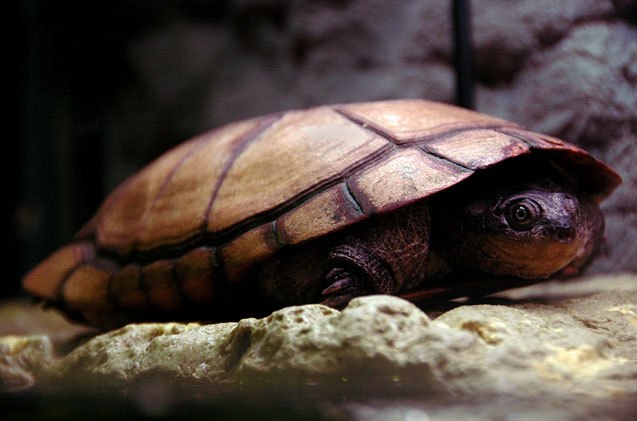African Sideneck Turtle


About African Sideneck Turtle
The African Sideneck Turtle belongs to the family Pelomedusidae, which encompasses several different species. Also known as African Mud Turtles or African Helmeted Turtles, these turtles can’t completely hide their heads in their shells. Instead, this turtle is known for folding its head underneath the upper edge of his shell after his head has been drawn to the side.
The African Sideneck Turtle’s face can be described as friendly and adorable in appearance.
The African Sideneck Turtle is a part of a group of turtles. They are also sometimes called East African Serrated Mud Turtles. Fifteen species that are within the Pelusios genus live in Africa, Madagascar, and the Seychelles, and Pelomedusa subrufa is found in Madagascar and many parts of Africa.
When they are found in the wild, these turtles are often seen in a range of natural habitats, such as shallow pools, large lakes, and rivers.
These turtles vary from one individual to another in terms of their size. For example, a P. castaneus adult turtle could be up to a foot long, while the P. sinuatus will grow to 20” as an adult, and the Pelomedusa subrufa will only be around 6-8” long as an adult.
When looking at the African Sideneck Turtle, you will notice two barbels that extend from the animal’s lower jaw. These are sensory organs that look a lot like a beard. These turtles also feature feet that are slightly webbed, and they will have sharp, long claws as well.
Also, the face of this turtle breed can be described as friendly and adorable in appearance, thanks to its large, round eyes and the mouth that looks like it is smiling.
The African Sideneck Turtle can vary in color from tan and dark brown, to gray and black. While some of these turtles can have lighter colored skin, they are generally darker, especially on the plastron, or underbelly area, which will also feature a poorly defined and wide yellow area.
The head of the African Sideneck Turtle will be anywhere from olive to brown in color, and you will also note a black marking on the top of the head.
African Sideneck Turtles are often seen in a range of natural habitats, such as shallow pools, large lakes, and rivers.
You can keep your African Sideneck Turtle in a pretty basic enclosure. Unless you live in a climate that is warm all year round, these turtles should not be kept outdoors because they don’t hibernate.
It is best to give your turtle a few inches of filtered water that is kept clean at all times, so filtration will be necessary. However, your turtle will enjoy basking as well, and will usually like swimming short distances before coming back to the surface. The amount of water in the tank will depend upon your turtle’s length. A good place to start is 6-10” deep.
Provide your turtle with several different forms of enclosure décor, focusing on driftwood or piles of rocks that can be used for basking. There should be hiding places available, too, so focus on decorating your tank with plants and décor that can give your turtle a sense of security when he does not want to be out in the open.
If you have a larger species, such as the P. gabonensis or the P. sinuatus, you will need a large 75-100 gallon aquarium, a larger tub, or a stock tank. On the other hand, if you have smaller species, such as the P. castanoides, Pelomedusa, or P. subniger, you can put turtles in a smaller 60-gallon tank, a stock tank, or a medium sized tub.
Incandescent or fluorescent light bulbs can be using for lighting the tank, but using ultraviolet bulbs will also provide UVB rays that will promote vitamin D3 production. Also, a heater will keep the temperature between 70-75°F in the water and 95-100°F in the basking area. Monitor the temperature in the water and in the basking area with an accurate thermometer.
The African Sideneck Turtle can vary in color from tan and dark brown, to gray and black.
Variety is important in an African Sideneck Turtle’s diet. You can feed your pet a commercial aquatic turtle diet, but your turtle will also enjoy eating crickets, worms, crayfish, and fish. You can also provide aquatic plants for snacking on, and these turtles like munching on the leaves of water lettuce and water hyacinth.
These turtles have become quite popular as pets, as they are hardy, curious, and active, but pet owners should be aware that these animals can sometimes be a little aggressive too. When you have a large enough enclosure, you can even house more than one of these turtles in the same space.
Even though these turtles are shy at the beginning, once they get used to their environment and family, they will be inquisitive and more outgoing. However, like all other aquatic turtles, you should consider your African Sideneck Turtle a display pet that likely will not be easy to hold. Turtles that hatched in captivity will make the best pets and will be the most social.
Photo credit: plecojan/Flickr; Bethabus/Flickr; stephanie tichenor/Flickr

Lisa Selvaggio is a freelance writer and editor, and our resident cats-pert, with certifications in pet nutrition and pet first aid. She enjoys producing content that helps people understand animals better so they can give their pets a safe and happy home.
More by Lisa Selvaggio

























